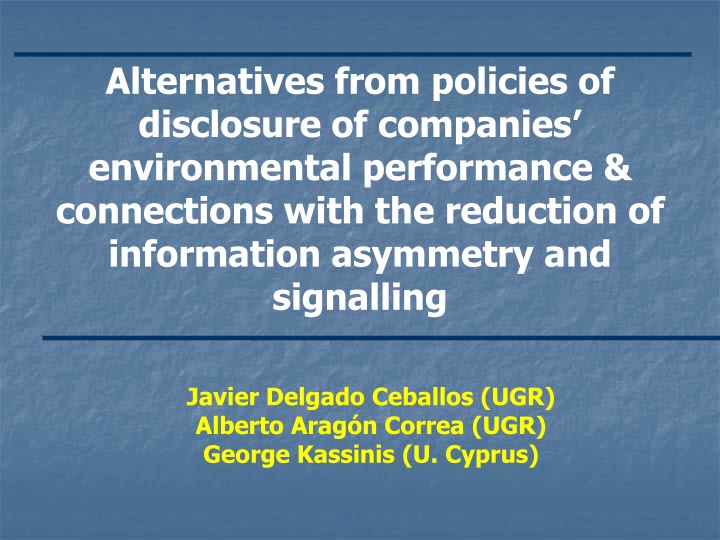
Alternative Policies for Disclosure of Environmental Performance in Companies
Explore alternatives to disclosure policies for companies' environmental performance, focusing on reducing information asymmetry and signaling. Motivations include the spread of pollutant registers worldwide and the importance of accurate information. Stakeholders, including regulatory entities, influence firms' environmental behavior, with an emphasis on public disclosure policies like Pollutant Release and Transfer Registers. Governments modify firms' environmental performance through information provision, reducing information asymmetry, and increasing pressure on firms and society. Managers' response to stakeholder pressures is crucial, affecting financial performance, competitiveness, and innovation benefits.
Download Presentation

Please find below an Image/Link to download the presentation.
The content on the website is provided AS IS for your information and personal use only. It may not be sold, licensed, or shared on other websites without obtaining consent from the author. If you encounter any issues during the download, it is possible that the publisher has removed the file from their server.
You are allowed to download the files provided on this website for personal or commercial use, subject to the condition that they are used lawfully. All files are the property of their respective owners.
The content on the website is provided AS IS for your information and personal use only. It may not be sold, licensed, or shared on other websites without obtaining consent from the author.
E N D
Presentation Transcript
Alternatives from policies of disclosure of companies environmental performance & connections with the reduction of information asymmetry and signalling Javier Delgado Ceballos (UGR) Alberto Arag n Correa (UGR) George Kassinis (U. Cyprus)
Motivation 1/2 Spread of Pollutant Releases and Transfer Registers around the world Governments spend a large amount of money on developing them Firms have to publish their emissions Env information affects financial performance
Motivation 2/2 Information may be not accurate Small installations escape from pressures Large installations (env efforts bad reputation) Divide installations to escape from the control Questions: Do these registers signal installations properly? Whether these registers include operational dynamics information, would it be sent a more accurate signal?
Introduction 1/4 Literature shows stakeholders influence firms environmental behaviour (Kassinis & Vafeas, 2006) Regulatory stakeholders appear to play the most influential role (Buysse & Verbeke, 2003).
Introduction 2/4 Growing importance of public disclosure policies - Pollutant Release and Transfer Registers (China, M xico, UE) Disclosure of installations env. emissions pressures firms to improve their env. performance SO FAR, LITERATURE has not analyzed the potential implications of the information emerging from these registers!!
Introduction 3/4 Governments Modify firms env performance Cost Provide information to s/h s Reduce info. asymmetry Increase s/h s pressure to firms S/H s & society Focus their pressure Right-to-know
Introduction 4/4 Managers The extent to which firms respond to stakeholder pressures is a critical concern (Kassinis and Vafeas, 2006; Bansal and Clealland, 2004). Financial performance (Klassen & Whybark, 1999) The competitiveness and innovation benefits (King & Lenox, 2002)
Regulatory S/H and the Environment Stakeholder theory (Freeman, 1984) Community, regulatory, organizational s/h, and the media (Henriques and Sadorsky, 1999) S/H regulatory (governments and legislators) Command-and-control methods Market-based incentives (tradable permits) Environmental information disclosure PRTRs
Regulatory S/H and the Environment Stakeholder theory (Freeman, 1984) Community, regulatory, organizational s/h, and the media (Henriques and Sadorsky, 1999) S/H regulatory (governments and legislators) Command-and-control methods Market-based incentives (tradable permits) Environmental information disclosure PRTRs
PRTRs background Willingness to know what was happening within industrial plants Public Right-to-know Bhopal (India) Existence of environmental information asymmetry between firms and communities Consumers and community are only partially aware of installations env behaviour
PRTRs background PRTRs send signals to s/h s and markets about installations performance Signaling theory suggests that key attributes of the firm provide information that shapes the impression that individuals form of the organizations and it can be used to examine firm reputation and its impact on individual behaviours, attitudes and decision making
PRTRs background S/H s are increasingly using PRTRs data to measure organizations env performance (Toffel & Marshall, 2004) Community s/h are concerned about installations env info released by PRTRs because of the consequences for env impacts and human hazards.
PRTRs background PRTRs rank installations summing annual emissions of substances released by a facility in a given year. It may be clear that it is a poor and crude proxy to indicate installations env performance as it depends on various factors as the chemical s characteristics and the medium which is release (Toffel & Marshall, 2004) As a consequence, some researchers (Karam, Craig and Currey, 1991; Toffel and Marshall, 2004) argue that in order to measure installations environmental data, it could be appropriate the use of the weighting emissions data using the each PRTRs standard limits or toxicity estimates so that TRI-based measures more accurately reflect real differences
PRTRs background PRTRs rank installations summing annual emissions of substances released by a facility in a given year. It may be clear that it is a poor and crude proxy to indicate installations env performance as it depends on various factors as the chemical s characteristics and the medium which is release (Toffel & Marshall, 2004) As a consequence, some researchers (Karam, Craig and Currey, 1991; Toffel and Marshall, 2004) argue that in order to measure installations environmental data, it could be appropriate the use of the weighting emissions data using the each PRTRs standard limits or toxicity estimates so that TRI-based measures more accurately reflect real differences
Hyphoteses Hypotheses 1: Toxicity-weighted environmental information classifies installations differently than in an absolute environmental pollution terms.
Further info: Operational dynamics Importance of operational dynamics to measure installation s env performance (Cairncross, 1992; and others) To know how efficient firms Need to adjust data from PRTRs (Karam et al.,1991)
Hyphoteses Hypotheses 2 a: Environmental information expressed in terms that take into account number of employees and toxicity-weighted environmental information may send a more accurate signal to firm management, regulators or market regarding a firm s environmental performance. Hypotheses 2 b: Environmental information expressed in terms that take into account number of operating hours and toxicity-weighted environmental information may send a more accurate signal to firm management, regulators or market regarding a firm s environmental performance.
Methodology Sample European Pollutant Emission Register (EPER) Year: 2004 Spain Chemical Industry (90 installations) Energy Industry (50 installations)
Methodology Creamos tres rankings: Ranking A: Instalaciones clasificadas por el pollution index Ranking B: Instalaciones ordenadas por el ratio PI/n mero de horas de actividad productiva Ranking C: Instalaciones clasificadas por el ratio PI/n mero de trabajadores Comparamos en ambas industrias A vs B A vs C
Methodology Pollution index (King and Lenox, 2004) PIi = ( weightc * waste generatedcij ) Reportable quantity Weighting Examples of chemicals 1 1.0 Brominated diphenylether 10 0.1 Cadmium 100 0.01 Benzene
Methodology Test no param trico Prueba de los rangos con signo de Wilcoxon
Results La clasificaci n de las instalaciones var a si incluimos la informaci n sobre el n mero de hora operativas (0,1 y 0.05) No existe diferencia en los rankings si se incluye la informaci n relativa al n mero de trabajadores en la instalaci n.
Discussion 1/2 Puede que EPER env e una informaci n distorsionada Una mayor complejidad en la informaci n m.a. de las instalaciones puede implicar el env o de se ales m s adecuadas a la sociedad.
Discussion 2/2 Ciertas peque as empresas pueden escaparse de la presi n por parte de los gobiernos. Las empresas responsables m.a. pueden tener un incentivo para presentar la informaci n recalculada ya que pueden enviar una se al mejor y, por tanto, mejorar su prestigio y/o imagen.


